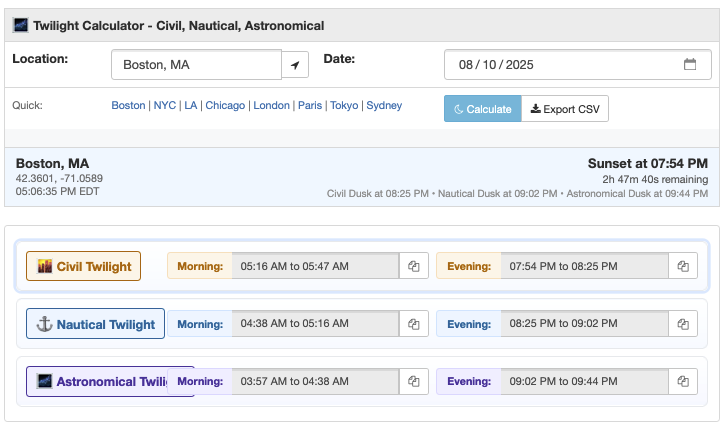Need to know when you can still work outside without a work light? Our civil twilight calculator shows you when natural light is sufficient for outdoor activities: when the sun is below the horizon but the sky still provides useful illumination.
Features of the civil twilight calculator
If you roughly agree with a 6 degree below the horizon benchmark, here's how to use the civil twilight tool:
- Morning and evening times: Shows both dawn-to-sunrise and sunset-to-dusk periods
- Duration display: See exactly how long civil twilight lasts
- Location search: Enter cities with autocomplete, plus GPS detection and coordinate input if you feel like mixing things up
- Copy buttons: Grab times instantly for planning
- CSV export: Download all twilight data for spreadsheet analysis
- Live countdown: For today's date, see the real-time countdown to next twilight event
We use SunCalc.js for calculations, and cities.json for the lat/lng lookup.
Compare twilight types
Civil twilight is just one of three commonly-accepted twilight divisions:
- Civil Twilight (−6° to 0°): Current tool – outdoor activities possible
- Nautical Twilight Calculator (−12° to −6°): Horizon visible for navigation
- Astronomical Twilight Calculator (−18° to −12°): Dark enough for deep-sky observation
- All Twilight Types: Compare all three on one page
Of course, you can also the other twilight types on this page, but civil twilight is highlighted.

What is civil twilight?
Civil twilight occurs when the sun's center is between 0° and 6° below the horizon. During this period, there's enough natural light for most outdoor activities. It happens twice daily: civil dawn (morning twilight before sunrise) and civil dusk (evening twilight after sunset).
The term "civil" distinguishes this from nautical and astronomical twilight. Civil twilight is the twilight that matters for civilian life, when you can still read a newspaper outside or continue construction work.
A brief history of arguing about darkness
Swiss polymath J.H. Lambert (probably) coined the term in the 1700s, but the debate didn't end there. Nobody could agree on the definition for centuries.
According to a 1916 Monthly Weather Review, "five distinct definitions are given for the ending of civil twilight" – was it 6°, 7°, 7.5°, or 8° below the horizon? (Imagine the debates!)
French physicist Auguste Bravais put it pragmatically: "The length of twilight is an element useful to be known: by prolonging the day, it permits the continuance of labor." Pretty good definition there, for this site which bills itself for the nights and weekends crowd.
Military operations
A special note here on how the military had to do their own thing (at least here in the United states).
The U.S. military uses specific acronyms: BMCT (Begin Morning Civil Twilight) and EECT (End Evening Civil Twilight) for planning.
Understanding twilight duration
Civil twilight duration varies dramatically by latitude and season:
- Equator: ~20-25 minutes year-round (sun drops nearly straight down)
- Mid-latitudes (40°): 25-35 minutes, longer in summer
- High latitudes (60°): 40-90+ minutes, but can last hours near summer solstice
- Polar regions: Sometimes experience weeks of continuous civil twilight. During summer, civil twilight can last all night – the sun never drops below 6° below the horizon. This creates the famous "white nights" of St. Petersburg.
If you want to see twilight maps with live-updating terminators representing all the twilights? Yeah, we've got that. Check out our day/night map to see.
Related tools
- Sunrise Sunset Calculator - Basic sun rising and setting times for a location
- Golden Hour Calculator - Extends into civil twilight for photography
- Sun Angle Calculator - Precise solar angles at twilight boundaries
- Moon Phase Calculator - Moon brightness during twilight
- Day Between Calculator - See days between solstices (or between whatever you'd like)
- Solar Tracker Map - Real-time sun position and terminator
- Daylight Hours Graph - Annual daylight patterns
- Hours Between Times - Calculate twilight duration
- Day of the year - Figure out how far into the year a certain date is
- Blue Hour Calculator - Occurs during civil twilight
No more debating whether it's "still light enough" – now you have exact times throughout the year. Though, let's be serious – Lambert would probably be amused that after 300 years, we're still arguing over his definition.
